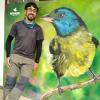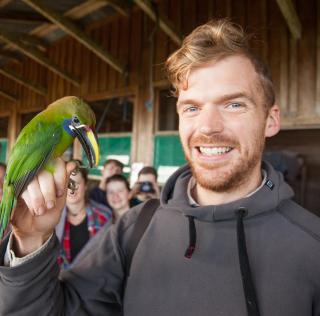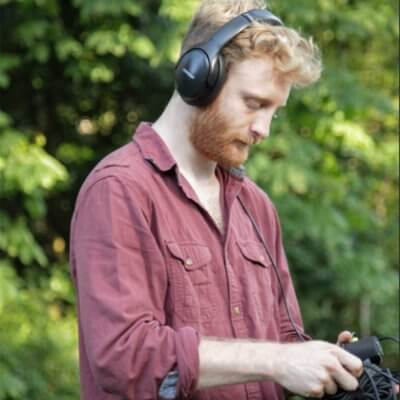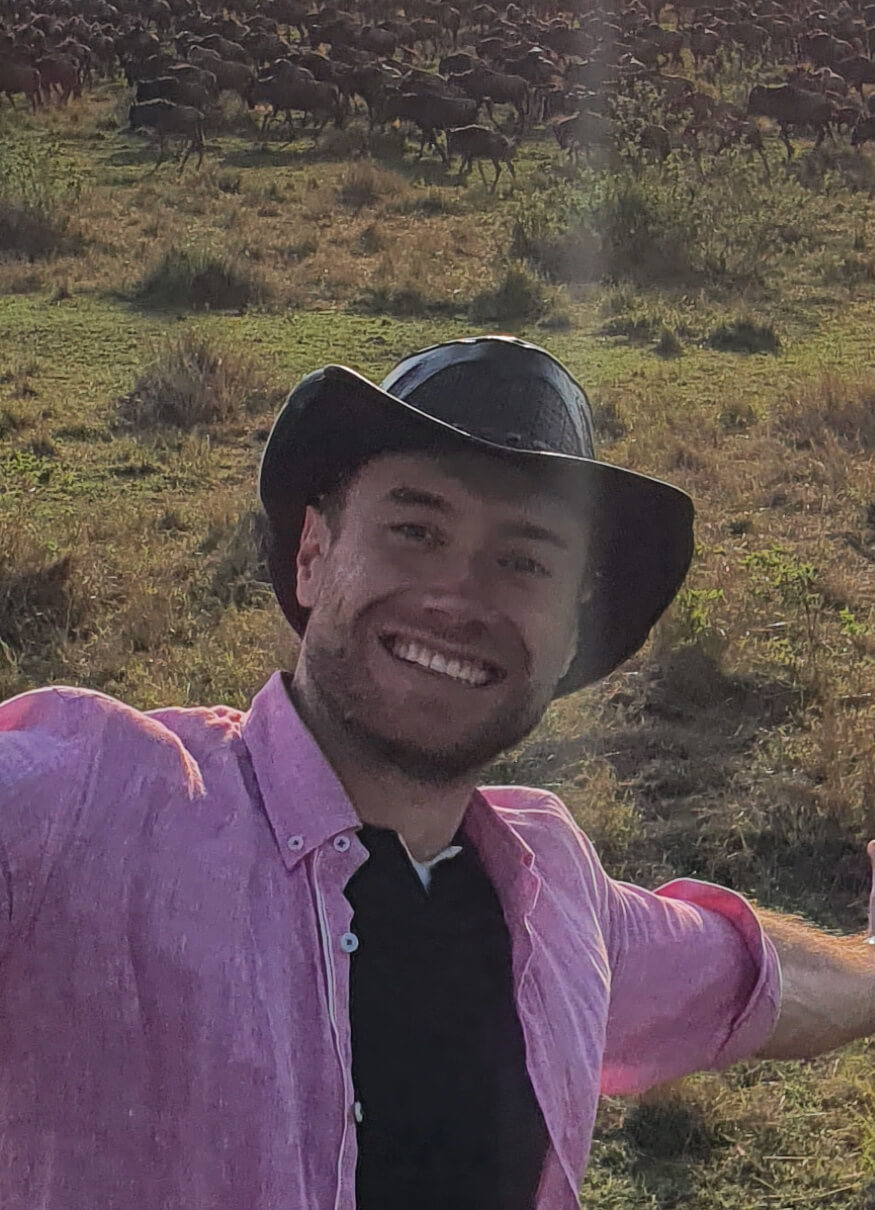Acoustic sensors enable efficient and non-invasive monitoring of a wide range of species, including many that are difficult to monitor in other ways. Although they were initially limited in application scope largely due to cost and hardware constraints, the development of low-cost, open-source models like the Audiomoth in recent years has increased access immensely and opened up new avenues of research. For example, some teams are using them to identify illicit human activities through the detection of associated sounds, like gunshots, vehicles, or chainsaws (e.g. OpenEars).
With this relatively novel dimension of wildlife monitoring rapidly advancing in both marine and terrestrial systems, it is crucial that we identify and share information about the utility and constraints of these sensors to inform efforts. A recent study identified advancements in hardware and machine learning applications, as well as early development of acoustic biodiversity indicators, as factors facilitating progress in the field. In terms of limitations, the authors highlight insufficient reference sound libraries, a lack of open-source audio processing tools, and a need for standardization of survey and analysis protocols. They also stress the importance of collaboration in moving forward, which is precisely what this group will aim to facilitate.
If you're new to acoustic monitoring and want to get up to speed on the basics, check out these beginner's resources and conversations from across the WILDLABS platform:
Three Resources for Beginners:
- Listening to Nature: The Emerging Field of Bioacoustics, Adam Welz
- Ecoacoustics and Biodiversity Monitoring, RSEC Journal
- Monitoring Ecosystems through Sound: The Present and Future of Passive Acoustics, Ella Browning and Rory Gibb
Three Forum Threads for Beginners:
- AudioMoth user guide | Tessa Rhinehart
- Audiomoth and Natterjack Monitoring (UK) | Stuart Newson
- Help with analysing bat recordings from Audiomoth | Carlos Abrahams
Three Tutorials for Beginners:
- "How do I perform automated recordings of bird assemblages?" | Carlos Abrahams, Tech Tutors
- "How do I scale up acoustic surveys with Audiomoths and automated processing?" | Tessa Rhinehart, Tech Tutors
- Acoustic Monitoring | David Watson, Ruby Lee, Andy Hill, and Dimitri Ponirakis, Virtual Meetups
Want to know more about acoustic monitoring and learn from experts in the WILDLABS community? Jump into the discussion in our Acoustic Monitoring group!
Header image: Carly Batist
Biologist who is new to the world of bioacoustics and ecological restoration.
- 0 Resources
- 0 Discussions
- 1 Groups
My passion is providing opportunities to others to advance the use of technology for long term monitoring of biodiversity (all levels) in Africa. Keen to connect with this community.
- 0 Resources
- 0 Discussions
- 1 Groups
- @claudlacroix
- | she/her
PhD fellow using deep learning to investigate marine fish acoustic signals and social behaviour.
- 0 Resources
- 1 Discussions
- 4 Groups
- @jmondragon
- | He/Him
- 0 Resources
- 1 Discussions
- 6 Groups
PhD researcher at University of Bath investigating Arctic underwater soundscapes
- 0 Resources
- 1 Discussions
- 1 Groups
I am a biology undergraduate student who is interested in the field of wildlife conservation and has skills in field observation and identification
- 0 Resources
- 0 Discussions
- 12 Groups
- @luciana.rocha
- | She/her
- 0 Resources
- 0 Discussions
- 3 Groups
- @Meagan
- | she/her
Supporting wildlife monitoring in remote Pacific Islands
- 0 Resources
- 1 Discussions
- 3 Groups
- @julianagc
- | she/her
With a background in biology, consulting, and education, I enjoy combining my many passions in applying ML and AI to biodiversity conservation.

- 1 Resources
- 0 Discussions
- 6 Groups
- @Tiago_Andre_Marques
- | he/him
University of St Andrews
TAM got his PhD in Statistics in 2007 and is currently a Senior Research Fellow working in CREEM at the University of St Andrews, interested in estimating animal abundance with a focus on passive acoustic density estimation. He holds an invited professor position at the Universid
- 0 Resources
- 1 Discussions
- 1 Groups
- @CameronChristopher
- | He/him
The Cornell Lab of Ornithology
Migrated after a decade in tech to conservation, passionate about participatory/community science, now working at the K. Lisa Yang Center for Conservation Bioacoustics, and the Cornell Lab of Ornithology.
- 0 Resources
- 1 Discussions
- 3 Groups
Terrestrial Ecologist
- 0 Resources
- 1 Discussions
- 4 Groups
HawkEars is a deep learning model designed specifically to recognize the calls of 328 Canadian bird species and 13 amphibians.
13 May 2025
The Biological Recording Company's ecoTECH YouTube playlist has a focus on webinars about Bioacoustic monitoring.
29 April 2025
This paper includes, in its supplementary materials, a helpful table comparing several acoustic recorders used in terrestrial environments, along with associated audio and metadata information.
15 April 2025
Conservation International is proud to announce the launch of the Nature Tech for Biodiversity Sector Map, developed in partnership with the Nature Tech Collective!
1 April 2025
PhD position available at the University of Konstanz in the Active Sensing Collective Group!
28 March 2025
InsectSet459 - the first large-scale open dataset of insect sounds, featuring 26,399 audio clips from 459 species of Orthoptera and Cicadidae.
24 March 2025
Naturalis is looking for a postdoc in AI for Ultrasonic Bioacoustic Monitoring
24 March 2025
Postdoctoral opening in the Bioacoustics and Behavioral Ecology Lab at Syracuse University
14 March 2025
Funding
Species identification from audio, focused on birds, amphibians, mammals and insects from the Middle Magdalena Valley of Colombia.
12 March 2025
Building species-specific habitat models for forest bird species using state of the art methods and remote sensing layers
28 February 2025
Osa Conservation is launching our inaugural cohort of the ‘Susan Wojcicki Research Fellowship’ for 2025, worth up to $15,000 per awardee (award value dependent on project length and number of awards given each year)....
10 February 2025
workshop introduced participants to the power of bioinformatics and next-generation sequencing (NGS) in conservation biology.
10 February 2025
June 2025
July 2025
September 2025
event
October 2025
November 2025
event
October 2024
event
September 2024
event
61 Products
| Description | Activity | Replies | Groups | Updated |
|---|---|---|---|---|
| Hi Mona. Yes, this is what we certainly what we are considering, but how to measure these indices by the hands of non-experts in the field is the advice that I need from the WL... |
|
Acoustics | 23 hours 50 minutes ago | |
| Would that be able to process locally stored acoustic data? One of the great things about birdnet analyzer is that it is local - it doesn't require uploading terabytes... |
|
Acoustics | 3 days 14 hours ago | |
| Do you collect or use sound recordings of habitats or species like birds, frogs, mammals, or insects in India? We need your expertise!... |
|
Acoustics | 1 week 1 day ago | |
| My name is Frank Short and I am a PhD Candidate at Boston University in Biological Anthropology. I am currently doing fieldwork in Indonesia using machine-learning powered passive... |
|
Acoustics, AI for Conservation, Animal Movement, Data management and processing tools, Early Career, Emerging Tech, Ethics of Conservation Tech, Protected Area Management Tools, Software Development | 2 weeks ago | |
|
|
Latin America Community, Acoustics, AI for Conservation, Camera Traps, Drones, Early Career | 2 weeks 5 days ago | ||
| There are a lot of parameters in principle here. The size of the battery. How much time in the field is acceptable before a visit? Once a week? Once a month? How many devices you... |
|
Acoustics | 3 weeks ago | |
| Hi Tom! I think the furry windjammer must be outside the casing to have the desired effect. It can be a bit tricky having this nice furry material that birds and other critters... |
|
Acoustics | 3 weeks 2 days ago | |
| Hi Lana,"similar field setup" means that the vocalizing animal should be surrounded by the recorders and you should have at least 4 audiomoths recording the same sound, then the... |
+9
|
Acoustics | 3 weeks 2 days ago | |
| Fantastic! Can't wait to hear updates. |
|
Acoustics | 4 weeks ago | |
| New stable release : v1.5.1We are pleased to announce the latest release with several important enhancement, fixes and documentation improvements to ensure compatibility with the... |
+15
|
Acoustics, AI for Conservation, Open Source Solutions, Software Development | 1 month 1 week ago | |
| Hello everyone,Thank you all for your contribution!You can read some updates about this project in this post.Julia |
|
Acoustics, Community Base, Data management and processing tools, Open Source Solutions | 1 month 2 weeks ago | |
| Hi Ryan, hmm, I had no idea there was a microphone named that. I thought about how it’s used to lure birds for netting, and I like Greek Mythology. I thought it was a perfect fit... |
|
Acoustics, Emerging Tech, Funding and Finance, Protected Area Management Tools, Software Development | 1 month 2 weeks ago |
Recording Orthoptera Sounds: International Workshop (Italy)
22 March 2024 9:25pm
How does behavior influence the use of technology for animal detection ?
22 March 2024 7:49pm
Leveraging Actuarial Skills for Conservation Impact
15 March 2024 12:31pm
19 March 2024 7:52pm
I would look into the TNFD (Taskforce on Nature-Related Disclosures), Finance for Biodiversity, Accounting for Nature, etc. which are all focusing on how to incorporate nature risk into corporate reporting and sustainability frameworks!
20 March 2024 3:48pm
Thank you Carly, I will definitely take a look.
BirdWeather | PUC
27 October 2023 7:45pm
2 November 2023 9:20pm
I love the live-stream pin feature!
14 March 2024 10:29pm
Hi Tim, I just discovered your great little device and about to use it for the first time this weekend. Would love to be directly in touch since we are testing it out as an option to recommend to our clients :) Love that it includes Australian birds! Cheers Debbie
16 March 2024 10:47pm
Hi @timbirdweather I've now got them up and running and winding how I can provide feedback on species ID to improve the accuracy over time. It would be really powerful to have a confirmation capability when looking at the soundscape options to confirm which of the potential species it actually is or confirm it is neither to help develop the algorithms.
Also, is it possible to connect the PUC to a mobile hotspot to gather data for device that isn't close to wifi? And have it so that it can detect either wifi or hotspot when in range? Thanks!
The Freshwater Sounds Archive
15 March 2024 10:32am
Senior Post-doctoral Researcher/Senior Research Associate Opportunity: Movement ecology of Greenland halibut
13 March 2024 2:00pm
Labelled Terrestrial Acoustic Datasets
16 February 2024 10:24pm
8 March 2024 11:54pm
Thanks for sharing Kim.
We're using <1 mA while processing, equating to ~9 Ah running for a year. The battery is a Tadiran TL-5920 C 3.6V Lithium, providing 8.6 Ah, plus we will a small (optional) solar panel. We also plan to implement a threshold system, in which the system is asleep until noise level crosses a certain threshold and wakes up.
The low-power MCU we are using is https://ambiq.com/apollo4/ which has a built-in low power listening capability.
9 March 2024 6:25am
<1 mA certainly sounds like a breakthrough for this kind of device. I hope you are able to report back with some real world performance information about your project @jcturn3 . Sounds very promising. Will the device run directly off the optional solar cell or will you include a capacitor since you cannot recharge the lithium thionyl chloride cell. I had trouble obtaining the Tadarian TL-5920 cells in Australia (they would send me old SL-2770s though) so I took a gamble on a couple of brands of Chinese cells (EVE and FANSO) which seemed to perform the same job without a hitch. Maybe in the USA you can get Israeli cells more easily than Chinese ones?
Message me if you think some feeding sounds, snoring, grooming and heart sounds of koalas would be any use for your model training.
9 March 2024 7:01am
Really interesting project. Interesting chip set you found. With up to around 2mb sram that’s quite a high memory for a ultra low power soc I think.
It might also be interesting while doing your research thinking about if there are any other requirements people could have for such a platform with a view towards more mass usage later. Thanks for sharing.
Here's what you missed at World Wildlife Day 2024
7 March 2024 9:02pm
15 March 2024 2:42pm
Support Amazon turtle project
4 March 2024 12:31pm
A PHD POSITION AT NOTTINGHAM TRENT UNIVERSITY
27 February 2024 9:42am
Needing help from the community: Bioacoustics survey
14 February 2024 9:46am
24 February 2024 7:23pm
Was great to chat with you Sofia and I would encourage others in the Acoustics community to help provide input for Sofia's study!
26 February 2024 8:57am
Thank you so much for your encouraging words! I'm thrilled to hear that you enjoyed our conversation, and I truly appreciate your support in spreading the word about my survey within the Acoustics community. Input from individuals like yourself is incredibly valuable to my study, and I'm eager to gather as much insight as possible. If you know of anyone else who might be interested in participating, please feel free to share the survey link with them. Once again, thank you for your support—it means a lot to me!
Best regards,
Sofia
Voice activated recording devices on satellite collars
18 February 2024 7:01am
24 February 2024 8:38am
I am sure Simon can chime in with exact specifications. I do not have it with me now. The centre distance between the attachment holes at each in end is 20mm wich will fit the standard holes in a collar from Vectronics Aerospace.
Simon posted images of the logger attached to a collar on a spotted Hyeana here: https://twitter.com/chamaillejammes/status/1441657479612542990
To-do now done in South Africa:
— Simon Chamaillé (@chamaillejammes) September 25, 2021
☑️ Being ridiculously proud of achieving data transfer over local GSM and LoRa networks for tracker
☑️ Being ridiculously proud of the way our wehear logger fits on lions and hyaenas. Looking forward to listening to their life. pic.twitter.com/CvgvovVjOp
25 February 2024 9:31am
We are studying muskoxen which are exposed to a polar night of between 3-4 month where the sun does not come over the horizon. On the other hand it also means that it will be continously OVER the horizon during the 3-4 summer months.
We are keeping an eye out for kinetic energy harvesting and there has been some interesting progress recently:
https://journals.plos.org/plosone/article?id=10.1371/journal.pone.0285930
A novel kinetic energy harvesting system for lifetime deployments of wildlife trackers | PLOS One
Wildlife tracking devices are key in obtaining detailed insights on movement, animal migration, natal dispersal, home-ranges, resource use and group dynamics of free-roaming animals. Despite a wide use of such devices, tracking for entire lifetimes is still a considerable challenge for most animals, mainly due to technological limitations. Deploying battery powered wildlife tags on smaller animals is limited by the mass of the devices. Micro-sized devices with solar panels sometimes solve this challenge, however, nocturnal species or animals living under low light conditions render solar cells all but useless. For larger animals, where battery weight can be higher, battery longevity becomes the main challenge. Several studies have proposed solutions to these limitations, including harvesting thermal and kinetic energy on animals. However, these concepts are limited by size and weight. In this study, we used a small, lightweight kinetic energy harvesting unit as the power source for a custom wildlife tracking device to investigate its suitability for lifetime animal tracking. We integrated a Kinetron MSG32 microgenerator and a state-of-the-art lithium-ion capacitor (LIC) into a custom GPS-enabled tracking device that is capable of remotely transmitting data via the Sigfox ‘Internet of Things’ network. Prototypes were tested on domestic dog (n = 4), wild-roaming Exmoor pony (n = 1) and wisent (n = 1). One of the domestic dogs generated up to 10.04 joules of energy in a day, while the Exmoor pony and wisent generated on average 0.69 joules and 2.38 joules per day, respectively. Our results show a significant difference in energy generation between animal species and mounting method, but also highlight the potential for this technology to be a meaningful advancement in ecological research requiring lifetime tracking of animals. The design of the Kinefox is provided open source.
@M_Stanton , you provide a nice list of uses of animal borne audio. We could add environmental sounds both abiotic and biotic.
We would LOVE to use audio more for ground truthing behavioural states and we would LOVE if the audio recordings could be GPS time synced...
@jared , it sounds interesting with the mentioned increased capabilities of the Iridium system. Can you link to any references for that?
Cheers,
Lars
26 February 2024 12:43am
I heard it through industry chatter but can't find a news release on it yet.
Insect vibrational communication on AudioMoths
23 February 2024 4:16pm
Funded PhD Opportunity: Moose Acoustics at the University of New Hampshire
13 February 2024 1:21pm
Post-doc possition - Field spanning movement ecology, ecology of fear, bio-logging science, behavioral ecology, and ecological statistics
10 February 2024 7:20am
Bio-Logging Science Symposium
9 February 2024 3:59pm
ISPA: A New System for Transcribing Animal Sounds
8 February 2024 7:17pm
PhD Opportunity - Exploring plants’ sensing capability with vibroacoustics
8 February 2024 5:35pm
Passionate engineer offering funding and tech solutions pro-bono.
23 January 2024 12:06pm
26 January 2024 3:18pm
Hi Krasi! Greetings from Brazil!
That's a cool journey you've started! Congratulations. And I felt like theSearchLife resonates with the work I'm involved round here. In a nutshell, I live at the heart of the largest remaining of Atlantic forest in the planet - one of the most biodiverse biomes that exist. The subregion where I live is named after and bathed by the "Rio Sagrado" (Sacred River), a magnificent water body with a very rich cultural significance to the region (it has served as a safe zone for fleeing slaves). Well, the river and the entire bioregion is currently under the threat of a truly devastating railroad project which, to say the least is planned to cut through over 100 water springs!
In face of that the local community (myself included) has been mobilizing to raise awareness of the issue and hopefully stop this madness (fueled by strong international forces). One of the ways we've been fighting this is through the seeking of the recognition of the sacred river as an entity of legal rights, who can manifest itself in court, against such threats. And to illustrate what this would look like, I've been developing this AI (LLM) powered avatar for the river, which could maybe serve as its human-relatable voice. An existing prototype of such avatar is available here. It has been fine-tuned with over 20 scientific papers on the Sacred River watershed.
And right now myself and other are mobilizing to manifest the conditions/resources to develop a next version of the avatar, which would include remote sensing capacities so the avatar is directly connected to the river and can possibly write full scientific reports on its physical properties (i.e. water quality) and the surrounding biodiversity. In fact, myself and 3 other members of the WildLabs community have just applied to the WildLabs Grant program in order to accomplish that. Hopefully the results are positive.
Finally, it's worth mentioning that our mobilization around providing an expression medium for the river has been multimodal, including the creation of a shortfilm based on theatrical mobilizations we did during a fest dedicated to the river and its surrounding more-than-human communities. You can check that out here:
Let's chat if any of that catches your interest!
Cheers!
2 February 2024 1:22pm
Hi Danilo. you seem very passionate about this initiative which is a good start.
It is an interesting coincidence that I am starting another project for the coral reefs in the Philipines which also requires water analytics so I can probably work on both projects at the same time.
Let's that have a call and discuss, will send you a pm with my contact details
There is a tech glitch and I don't get email notifications from here.
Owl call detection software
17 October 2023 4:47am
26 January 2024 3:33pm
I have a question about Arbimon. I'm working on a project looking for bird use of wet meadow (and associated matrices of habitat). We have two bird lists we've created for BirdNet, a "Master List" of all species (to get an understanding of community data as per input from Indigenous partners) and a "Focal Species List" as per the land managers in put. I will have volunteers doing manual verification + passive listening to attempt to catch false positives and species BirdNet has missed. I recently learned about Arbimon from the Soundscapes to Landscapes project and I'm curious about the audio detector function. Is it detecting spectrograms/sonograms from a provided classifier or does it function similar to BirdNet where we can tell it which species to look for?
30 January 2024 9:05am
We are currently working on Eurasian Pygmy, Tengmalm's and Tawny owl calls recognition. It's not a trivial task if you want to include different call types (male, female, pair, chicks), that's why we started with only 3 species. If you are interested in these 3 European species, drop me a line.
30 January 2024 10:53pm
Hi Teresa,
Thanks for your interest in Arbimon! The platform has a couple different analysis tools that range from unsupervised (like audio event detection & clustering, or AED-C) to semi-automated (pattern matching, random forest). We've got lots more info about each in our support docs here.
The AED-C is an unsupervised machine learning model, so you aren't providing any labels (though the validation page allows you to assign events or clusters as particular species after the fact). The pattern matching is a cross-correlation template matching function where you provide 1 template (example of the species-specific call you're looking for) and the algorithm looks for matches similar to that template. Random forest is a decision-tree-based machine learning model where you provide training clips (presence & absence clips for a species) which the model uses to learn how to classify that species' call. We have developed a number of CNNs (like BirdNet is) but they have more of a regional focus (e.g., one for Kenya, one for western Sumatra, etc. etc.). Right now we run these on the backend, but we are currently working on a public-facing CNN page that we hope to phase in this year.
Hope that helps, but feel free to reach out if you have more questions! You're welcome to also email me directly at carly@rfcx.org .
All the best,
Carly
Power managment/Recharging System and Communication System
2 January 2024 4:06pm
26 January 2024 8:49am
"Seychelles and South Africa did not allow Starlink to operate"
This is not good, has implications for anti-poaching measures.
26 January 2024 9:03am
Power usage for microcontrollers with solar is much more manageable. For Raspberry Pi's and higher it gets expensive and big.
I'm quite impressed by the specs from the Goal Zero Yeti devices. This can have high capacity and be charged with Solar. Not small though. And the price is not in proportion to the Pi's.
So this 200x model for example, would be close to 16 days running the audio recorder. Let's say 10. without solar. Add solar? Depends on the size of the panels I guess. Power usage for mobile networking? Depends on how much you transmit.
Probably some well documented experiments would be really nice for people here. Sounds like something nice for the next set of grants :)
26 January 2024 2:11pm
Real nice video. I'll have another look in the weekend in detail.
New paper - An integrated passive acoustic monitoring and deep learning pipeline for black-and-white ruffed lemurs in Ranomafana National Park, Madagascar
23 January 2024 4:08pm
19 February 2024 4:22pm
19 February 2024 5:46pm
Wireless communication for Jungle
23 January 2024 1:21pm
Questionnaire for Pain Points and Needs in Bioacoustics
23 January 2024 12:37pm
Monitoring setup in the forest based on the wifi with 2.4 GHz frequency.
30 December 2023 4:39pm
18 January 2024 8:17pm
Hi Dilip,
I do not have data about signal distortion in a forest area and with the signal you are intended to use.
However, in a savannah environment, when I put a tour on the highest point of the park, Lora signal (avg 900MHz) is less distorted than WiFi signal (2.4GHz). This is normal as a physics law: the frequency determines the wave length, and the less the length (obviously the less the frequency), the less obstructed the signal.
So, without interfering with your design, I would say that in a forest configuration, WiFi will need more access points deployed and may be more costly, and in your context, even when using LoRa, you will need more gateways than I have in a savannah.
To design the approximate number of gateways, you may need to use terrain Visibility analysis.
To design the cameras deployment, you will need to comply with the sampling methods defined in your research. However, if it is on for surveillance reasons, you may need to rely on terrain visibility analysis also.
Best regards.
22 January 2024 6:22pm
I've got quite a lot of experience with wireless in forested areas and over long(ish) ranges.
Using a wifi mesh is totally possible, and it will work. You will likely not get great range between units. You will likely need to have your mesh be fairly adaptable as conditions change.
Wireless and forests interact in somewhat unpredictable ways it turns out. Generally, wireless is attenuated by water in the line-of-sight between stations. From the Wifi perspective, a tree is just a lot of water up in the air. Denser forest = more water = worse communications. LoRa @ 900Mhz is less prone to this issue than Wifi @ 2.4Ghz and way less prone than Wifi @ 5Ghz. But LoRa is also fairly low data rate. Streaming video via LoRa is possible with a lot of work, but video streaming is not at all what LoRa was build to do, and it does it quite poorly at best.
The real issue I see here is to do with power levels. CCTV, audio streaming, etc are high data rate activities. You may need quite a lot of power to run these systems effectively both for the initial data collection and then for the communications.
If you are planning to run mains power to each of these units, you may be better off running an ethernet cable as well. Alternatively, you can run "power line" networking, which has remarkably good bandwidth and gets you back down to a single twisted pair for power and communications.
If you are planning to run off batteries and/or solar, you may need a somewhat large power system to support your application?
23 January 2024 1:19am
UniFi Outdoor WiFi Access Points - Ubiquiti
Deploy WiFi, anywhere. Incredibly versatile access points for extending WiFi over campuses, indoors and outside. Mesh-ready with long-range antenna integration.
I would recommend going with Ubiquity 2.4Ghz devices which have performed relatively well in dense foliage of the California Redwood forests. It took a lot of tweaking to find paths through the dense tree cover as mentioned in the previous posts.
Audiomoth Bat Call Triggering Settings
22 January 2024 9:48am
22 January 2024 7:26pm
Nils Bouillard (@Nilsthebatman) would be good to talk with!
Adrià López-Baucells also has lots of useful info on his website.
23 January 2024 1:09am
Thank you @carlybatist
Program Officer - Bioacoustics, WILDLABS
22 January 2024 9:37pm
Introducing Citibats Cambodia Citizen Science Project
22 January 2024 7:29am







































































19 March 2024 6:35pm
Thank you for your response Akiba. I will have a look. 👏🏻